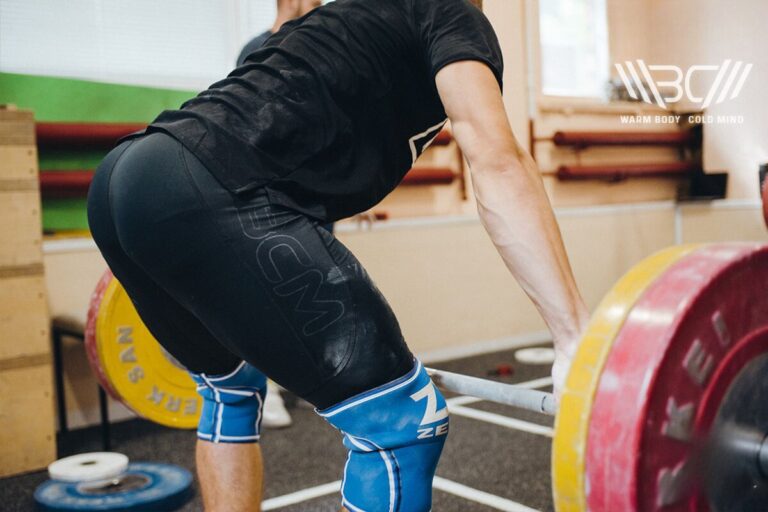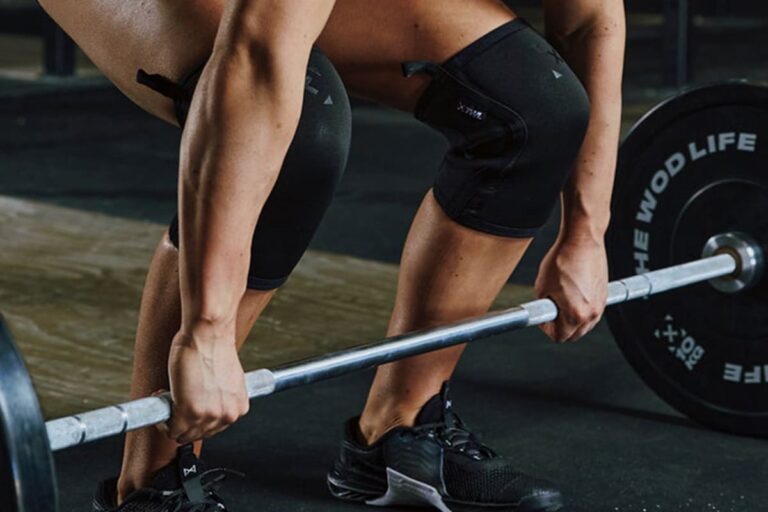Jogging in Place Exercise: The Surprising Benefits and How to Maximize Your Workout
While fitness enthusiasts usually love everything gym related – the atmosphere, the people, the energy – they still get lazy sometimes and do not feel like leaving the house. The lack of motivation, fatigue, or the usual ‘I don’t have time now.’ or the classic ‘I’ll start on Monday!’.
If you’ve ever felt the same, let me tell you about jogging in place exercise. Jogging indoors is the perfect solution when you feel unmotivated but want to attend your cardio session.
Thanks to this activity, you don’t even have to leave your living room to get a good workout, burn some calories, and improve your endurance. It’s the equivalent of having a private treadmill that never asks for money or checks the weather.
In this article, you’ll read about the personal benefits of jogging in place, explore different variations, and discover tips to maximize your energetic indoor escapades. So put on your compression shorts because nothing beats running in compression shorts.
Let’s jog! … In place!
What Is Jogging in Place? — Jogging in place is a form of exercise where you simulate the motion of running while staying in one spot.
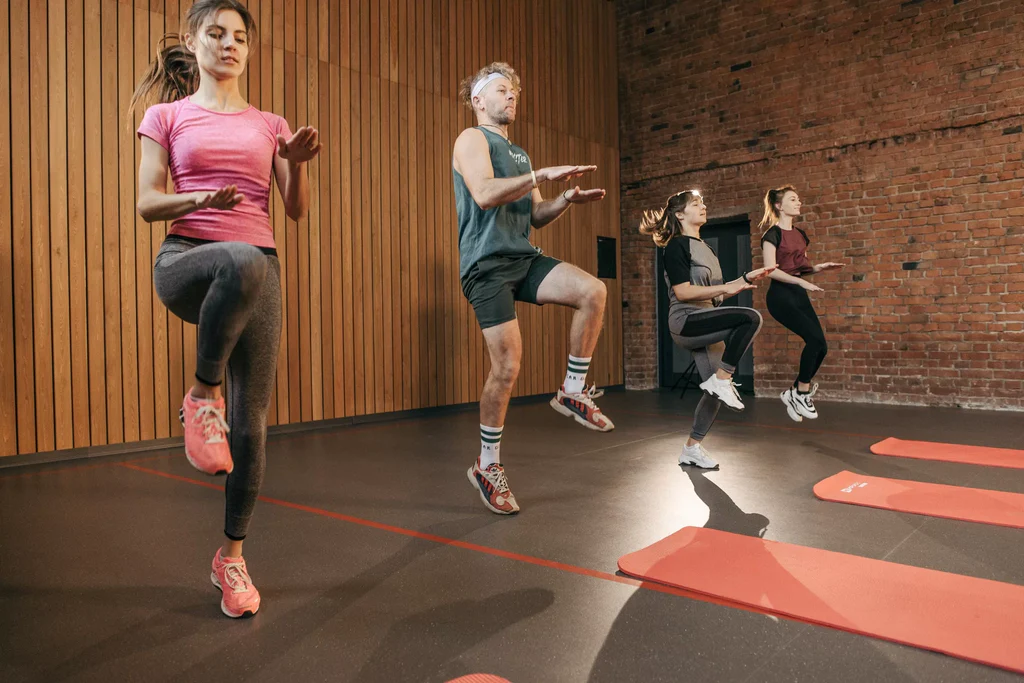
Long-Term Benefits of Jogging in Place
Let’s get right into it and check out all the benefits jogging in place has for you! This simple, yet effective exercise is proven to increase your physical fitness, boost cardiovascular health and burn calories.
A study was done by Sports Med. back in 2016 that concluded that running economy, biomechanical factors, perception, muscle temperature, and endurance performance might increase while wearing compression shorts. Muscle soreness, injury, and inflammation should also decrease.
But, of course, there is more.
✅ Cardiovascular Health
Jogging in place gets your heart pumping, improving cardiovascular endurance and strengthening your heart muscles.
✅ Calorie Burning
This high-impact activity helps burn calories and aids in weight loss. The longer you jog in place, the more calories you’ll torch. Jogging in place for only 30 minutes will burn about 280 calories.
✅ Leg Strength and Endurance
The repetitive motion of jogging in place may strengthen the trunk and abdominal muscles that contribute to spinal stability, minimize muscular fatigue, and increase aerobic exercise capacity.
✅ Joint-friendly
Unlike running on hard surfaces, jogging in place is low-impact, reducing stress on your joints while still providing an effective workout.
✅ Improved Coordination
Maintaining balance and rhythm while jogging in place helps enhance your overall coordination and motor skills.
✅ Mood Booster
This exercise releases endorphins, which can uplift your mood, reduce stress, and increase overall well-being.
✅ Accessibility
Jogging in place is accessible to people of different fitness levels and abilities, allowing for easy modification and gradual progression.
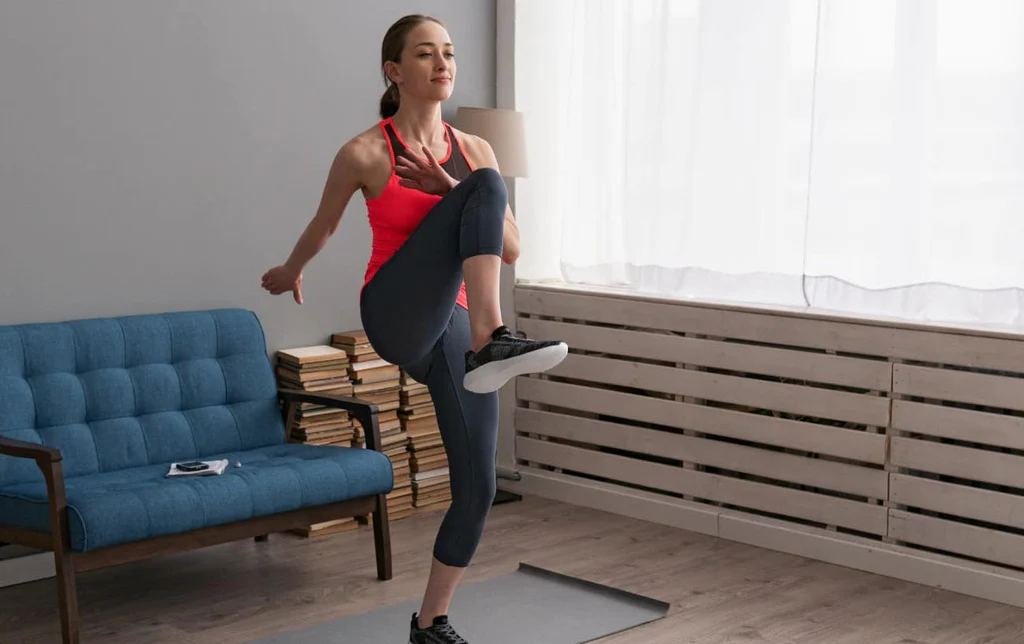
Proper Techniques for Jogging in Place
Although jogging in place seems pretty straightforward, you still need to pay attention to your technique to ensure your workout is efficient while minimizing any risk of injury.
1. Posture
Maintain superhero posture: stand tall, head up, shoulders back, and core engaged. Keep your gaze forward and relax your shoulders. Engage your core and breathe deeply for optimal oxygenation. With proper posture, you’ll enhance your performance and minimize discomfort. Over time, jogging in place can even improve your posture and lumbar stability.
2. Arm Movements
Imagine you’re a lively pendulum, swinging your arms back and forth in sync with your leg movements. Keep your elbows at a comfortable 90-degree angle and let your arms naturally turn forward and backward. As one leg moves forward, the opposite arm swings forward as well. This natural arm-leg coordination adds rhythm and balance to your jog.
3. Leg Movements
Begin by lifting your knees up towards your chest, aiming for a comfortable height. Maintain a steady and controlled pace throughout your jog. Land softly on the balls of your feet with each step rather than with a heavy impact. This helps reduce stress on your joints and promotes a smoother stride.
Keep your legs relaxed and avoid locking your knees. Instead, maintain a slight bend in your knees to absorb shock and maintain flexibility. Focus on a fluid motion, swinging your legs forward and back naturally and rhythmically.
Also, keep in mind that regardless of whether you are jogging in place, the environment may also greatly benefit your overall results while doing this exercise.
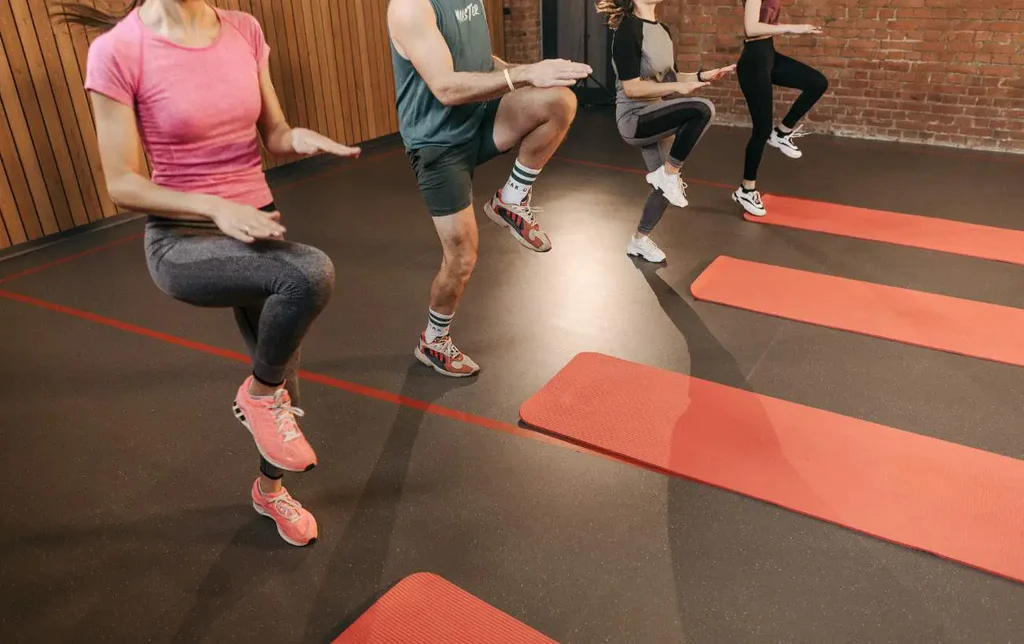
Common Mistakes and How to Avoid Them
How can you go wrong when you’re just running in place? It’s such a simple exercise.
You may not realize it at first glance, but the mistakes that occur are quite common and not only can they make your workout less efficient, but they can even lead to injury.
1. Incorrect Posture
Incorrect posture during jogging in place can hinder your workout. Slouching limits oxygen intake, strains your neck, shoulders, and lower back, increasing the risk of discomfort. Poor posture disrupts balance and stability, making it harder to maintain form. Muscle imbalances may occur, decreasing workout effectiveness.
2. Not Engaging the Core
Without core activation, your stability and balance suffer, making it harder to maintain proper form. This can lead to inefficient movements and even the risk of injury. A weak core also fails to provide adequate support for your spine, potentially resulting in lower back discomfort or strain.
3. Neglecting Arm Movements
Remember, a well-rounded jog involves both your legs and arms. Without arm swings, you miss a chance to engage your upper body muscles, resulting in an unbalanced workout. But it’s not just about aesthetics. You’re also missing an opportunity to boost your calorie burn by neglecting arm movements. Those arm swings add an extra kick to your workout, helping you torch more calories and reach your fitness goals faster.

Incorporating Jogging in Place Into Your Workout Routine
One of the reasons to incorporate running in place into your training is its accessibility. It can be done anywhere, anytime, without any special equipment. It’s an extremely convenient choice for home workouts, in a hotel room, or while watching your favorite TV shows. All you need is some free space and the desire to exercise.
The real beauty of it, however, is that jogging in place is fantastic as a part of your other workouts, too! Let me show you just how versatile it is.
1. As a Warm-up Activity
Look no further than jogging in place to get you warmed up for your workout. It activates your muscles, increases blood flow, and raises your core body temperature. It helps loosen up your joints and prepares your body for more intense movements ahead.
2. High-Intensity Interval Training (HIIT) Involving Jogging in Place
HIIT involves alternating between short bursts of intense activity and periods of active recovery. When combined with jogging in place, this creates a dynamic and challenging workout that elevates your heart rate, torches calories and improves your cardiovascular endurance.
3. Jogging in Place as a Low-impact Cardio Option
Jogging in place is considered a low-impact activity because it minimizes the stress on your joints, making it suitable for individuals with joint sensitivities, injuries or those looking for a more joint-friendly workout. Unlike high-impact exercises like running or jumping, jogging in place reduces the risk of excessive strain or impact-related injuries.
By engaging in a consistent and controlled jog in place, you can still enjoy the benefits of a cardio workout without putting extreme pressure on your knees, ankles, or hips.
Whether you’re cardioing at home or in the gym, you should wear comfortable clothes. One of the elements of such clothing is compression shorts. What are compression shorts, you may ask?
They are those tight-fitting shorts that you usually see on cyclists, runners, etc. You may have even seen basketball or soccer players wearing compression shorts under their uniforms. Basically, any sport involving a lot of movement would benefit from compression shorts – so is the case with weightlifting, functional fitness, or similar.
Now, you might be asking yourself, are compression shorts good for running? And if yes, how good are they? Well, that’s a topic for another article because that will take a lot of time, but in short- they support your muscles during workouts. So yes, they are good for running.
You can consider the effectiveness and benefits of training in compression shorts on the example of any model WBCM.

The Warm Body Cold Mind compression shorts are comfortable and breathable, and the compression, the most important factor, is impressive. You really do feel them squeezing your skin, but not in an uncomfortable way.
You can get some of them in more than one color option, which is excellent if you are looking for added variety in your workout clothes.
The material is super comfortable and breathable. All WBCM shorts are made of a special material called Supplex Sport, so you’ll never worry about your clothes being worn out due to frequent use.
Another thing worth noting is that all of the WBCM shorts wash beautifully – the color doesn’t fade, and they keep their form no matter how many times you wash them.
WBCM Men’s Shorts Review
If you want to take advantage of the benefits of compression shorts, try one of the models offered by Warm Body Cold Mind.
Pros
- Excellent compression
- Reasonable price
- Durable, comfortable material
- Quality made; will last you a long time
Cons
- Hem might sometimes ride up during workouts
Conclusion
Incorporating jogging in place into your workout routine can improve your cardiovascular fitness, burn calories, strengthen your muscles, and boost your overall endurance. It’s a simple yet dynamic exercise that requires minimal space and equipment, making it accessible to everyone.
Now it’s your turn to take action! Lace-up your imaginary running shoes, find a comfortable spot, and try jogging in place. Don’t forget to engage your core, swing your arms, and maintain proper posture for optimal results. And remember, listen to your body, start at your own pace, and gradually increase the intensity as you progress.
I would love to hear from you! Have you tried jogging in place before? What are your favorite variations or tips? Do you have any questions or thoughts to share? Let me know in the comments section below.
References:
- “CALORIES BURNED PER HOUR,” DEPARTMENT OF HEALTH SERVICES State of Wisconsin Division of Public Health P-40109 (09/2005) https://www.dhs.wisconsin.gov/publications/p4/p40109.pdf (accessed Jun. 07, 2023).
- Oleksandr Zagrebelnyi, “Is Running In Place Effective? Benefits And Effective Workout,” https://pacepassion.com/running-guides/is-running-in-place-effective/ (accessed Jun. 07, 2023).
- A Agus, M P Sari, “The Impact of Jogging on the Improvement of Physical Fitness,” 10.2991/assehr.k.200824.199, https://www.researchgate.net/publication/344090748_The_Impact_of_Jogging_on_the_Improvement_of_Physical_Fitness (accessed Jun. 07, 2023).
- Eliza Martinez, “Jogging in Place for Belly Fat,” https://healthyliving.azcentral.com/jogging-place-belly-fat-5958.html (accessed Jun. 07, 2023).
- Florian Azad Engel, Hans-Christer Holmberg, Billy Sperlich, “Is There Evidence that Runners can Benefit from Wearing Compression Clothing?,” Sports Med. 2016 Dec;46(12):1939-1952. doi: 10.1007/s40279-016-0546-5. https://pubmed.ncbi.nlm.nih.gov/27106555/ (accessed Jun. 07, 2023).
- Marianna Halász, Jelka Geršak, Péter Bakonyi, Gabriella Oroszlány, András Koleszár, and Orsolya Nagyné Szabó, “Study on the Compression Effect of Clothing on the Physiological Response of the Athlete,” Materials (Basel). 2022 Jan; 15(1): 169. https://www.ncbi.nlm.nih.gov/pmc/articles/PMC8746162/ (accessed Jun. 07, 2023).
- Misuk Cho, PhD, PT, “Effects of running in place accompanied by abdominal drawing-in on the posture of healthy adults,” J Phys Ther Sci. 2015 May; 27(5): 1613–1616 https://www.ncbi.nlm.nih.gov/pmc/articles/PMC4483452/ (accessed Jun. 07, 2023).
- Shane F. O’Riordan, Rod McGregor, Shona L. Halson, David J. Bishop, James R. Broatch, “Sports compression garments improve resting markers of venous return and muscle blood flow in male basketball players,” Journal of Sport and Health Science Volume 12, Issue 4, July 2023, Pages 513-522. https://www.sciencedirect.com/science/article/pii/S2095254621000922 (accessed Jun. 07, 2023).
- Heidi Moawad, M.D. Jennifer Berry, Alicia Sparks Akers “What to know about endorphins,” Updated on March 6, 2023 https://www.medicalnewstoday.com/articles/320839 (accessed Jun. 07, 2023).
- Franke, T.P.C., Backx, F.J.G. & Huisstede, B.M.A. “Lower extremity compression garments use by athletes: why, how often, and perceived benefit,” BMC Sports Sci Med Rehabil 13, 31 (2021). https://doi.org/10.1186/s13102-020-00230-8. https://bmcsportsscimedrehabil.biomedcentral.com/articles/10.1186/s13102-020-00230-8 (accessed Jun. 07, 2023).
- Misuk Cho, PhD, PT and Ilsub Jun, MSc, PT, “The Effects of Running in Place on Healthy Adults’ Lumbar Stability,” J Phys Ther Sci. 2014 Jun; 26(6): 821–824. https://www.ncbi.nlm.nih.gov/pmc/articles/PMC4085200/ (accessed Jun. 07, 2023).
- Deelen, I., Janssen, M., Vos, S. et al. “Attractive running environments for all? A cross-sectional study on physical environmental characteristics and runners’ motives and attitudes, in relation to the experience of the running environment,” BMC Public Health 19, 366 (2019). https://bmcpublichealth.biomedcentral.com/articles/10.1186/s12889-019-6676-6 (accessed Jun. 07, 2023).
- Kyung Woo Kang, PhD, PT, Sang In Jung, MS, PT, Do Youn Lee, MS, PT, Kyoung Kim, PhD, PT, and Na Kyung Lee, PhD, PT, “Effect of sitting posture on respiratory function while using a smartphone,” J Phys Ther Sci. 2016 May; 28(5): 1496–1498. https://www.ncbi.nlm.nih.gov/pmc/articles/PMC4905897/ (accessed Jun. 07, 2023).
Author: Ihor Shymechko
Coach, PRO Olympic Weightlifter
Ihor Shymechko is a renowned Ukrainian weightlifter. He has represented his country in several Olympic Games, notably in 2008, 2012, and 2016. His impressive career includes winning the European championship in 2009 and earning a silver medal in 2011 in the +105 kg division. Shymechko also earned a Ph.D. from Lviv State University of Physical Culture.







